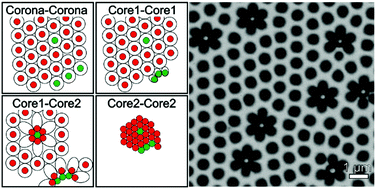Collapse-induced phase transitions in binary interfacial microgel monolayers†
Abstract
Microgels, consisting of a swollen polymer network, exhibit a more complex self-assembly behavior compared to incompressible colloidal particles, because of their ability to deform at a liquid interface or collapse upon compression. Here, we investigate the collective phase behavior of two-dimensional binary mixtures of microgels confined at the air/water interface. We use stimuli-responsive poly(N-isopropylacrylamide) microgels with different crosslinking densities, and therefore different morphologies at the interface. We find that the minority microgel population introduces lattice defects in the ordered phase of the majority population, which, in contrast to bulk studies, do not heal out by partial deswelling to accommodate in the lattice. We subsequently investigate the interfacial phase behavior of these binary interfacial assemblies under compression. The binary system exhibits three distinct isostructural solid–solid phase transitions, during which the coronae between two small particles collapse first, followed by the collapse between small–large and large–large microgel pairs. A similar hierarchy of phase transitions is found for mixtures of microgels and core–shell particles. Simulations based on augmented potentials qualitatively reproduce the experimentally observed phase transitions. We rationalize the presence of this hierarchy in phase transitions from differences in the interfacial morphology between the species: the larger coronae of softer (and therefore larger) microgels provide a higher resistance to phase transitions compared to the smaller coronae of the more crosslinked microgels and core–shell particles. The control of phase transitions via the molecular architecture further allows the formation of characteristic, flower-like defects by introducing particles with “weaker” coronae that are more prone to collapse with their neighboring particles. Our findings underline the dominating role of the corona for interfacial microgel assemblies, which acts as an energy barrier, shifting the collapse to higher surface pressures.



 Please wait while we load your content...
Please wait while we load your content...